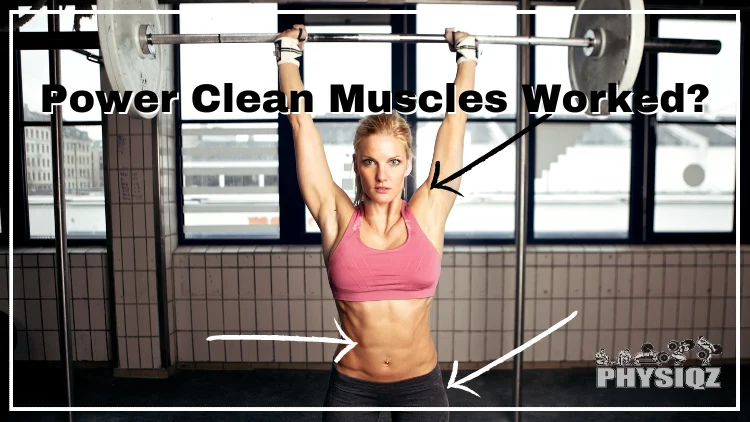
You might be curious about what are the power clean muscles worked.1
The power clean is a compound movement that works nearly every muscle in the body, and to be more specific, the muscles seen below detail the primary movers and stabilizers so you can figure out which muscles will be targeted most and which should be sore.
Strength athletes and gym goers commonly use this lift to get in shape and/or build strength; however, the power clean involves a high level of specificity which does not translate into functionality among other lifts or day-to-day life.
For this reason, studies find the opposite benefit — where the power clean isn’t the best to get in shape and, instead, should generally be performed to improve proficiency and strength of the power clean itself, as well as other Olympic lifts.
So non-competitive lifters may be better suited with the big compound movements that consist of squats, deadlifts, and bench pressing as these translate better across other lifts in the gym and life in general.
For those who deem power cleans worthy of keeping in their training regimen or simply enjoying the progression, every muscle worked can be seen here, and a little-known form trick that can help prevent injuries is also divulged.
What Are the Power Clean Muscles Worked?
The power clean is a compound movement that engages primarily muscles of the lower body and some of the upper body.
These power clean muscles worked include the posterior chain, quads, back, core and adductors— they are utilized in the starting phase of the movement when the loaded barbell is on the ground and secondary muscles like the delts, core and quads are recruited in the catch position at the top phase.
Muscles of the posterior chain are located on the backside and comprise the latissimus dorsi (lats), erector spinae, hamstrings, gluteus maximus and calves.
The power clean is a compound Olympic weightlifting movement that is superior at developing speed, and power, conferring total body strength to lifters.
In addition to the Olympics, the power clean finds itself in training modalities such as CrossFit and due to activating multiple muscle groups, it is excellent at expending calories. It is also a functional exercise that can make everyday activities easier.
Glutes (Gluteus Medius, Gluteus Minimus & Gluteus Maximus)
This is the largest muscle of the human body and is a critical muscle in the power clean used to extend the hip joint.
The gluteus maximus is responsible and makes possible the explosive extension of the hips during the termination of the second pull allowing for the propulsion of the bar outward and upward for the transition into the catch position.
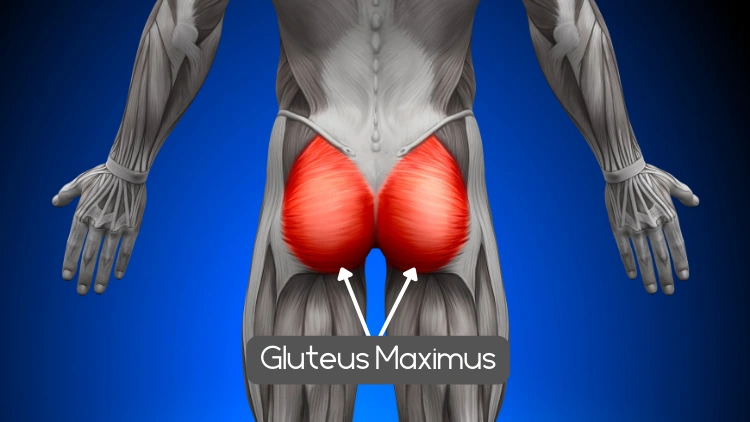
Source: decade3d via Canva.com2
The other components of the glutes, the gluteus medius and minimus help to provide stability to the hips through the power clean.
Hamstrings
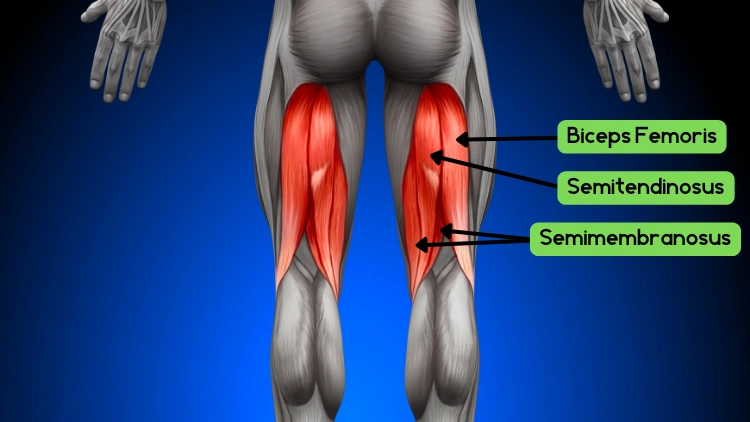
Source: decade3d via Canva.com3
The hamstrings are a major muscle located at the back of the quads that provide stability to the knee joint during knee flexion by the quads. In the power clean, they have a primary role in both knee and hip flexion particularly during the pulling phase when the bar is traveling from the floor to the mid thighs.
Adductors
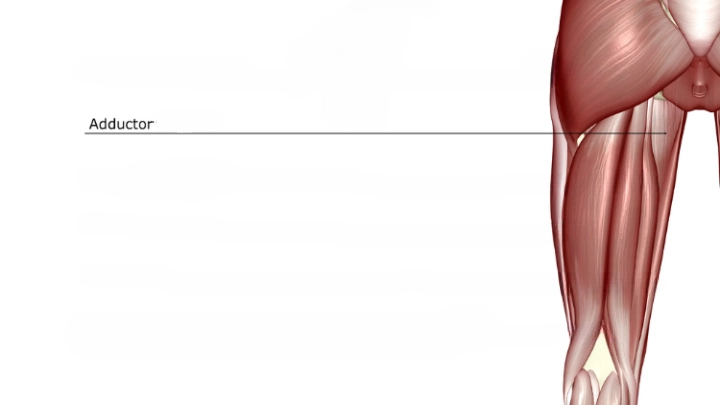
Source: Science Photo Library via Canva.com4
The adductors help and assist during the hip thrust and during the partial squat.
Calves (Soleus & Gastrocnemius)
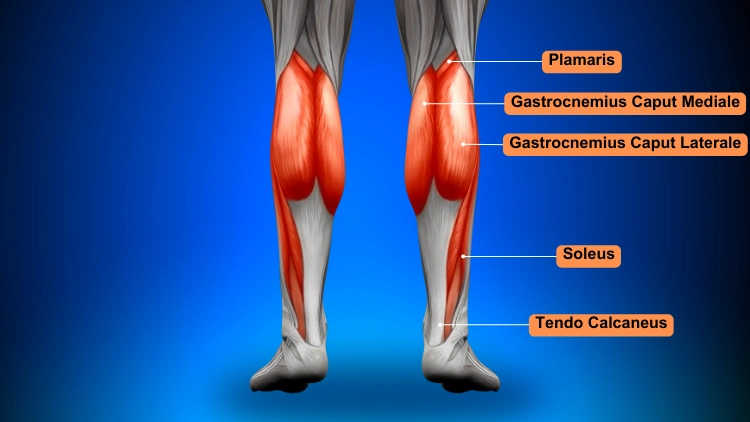
Source: decade3d via Canva.com5
Calves are part of the posterior chain and facilitate flexion and extension of the foot at the ankle. They primarily plantar flex (when the top of the foot is pointing away from the leg) the feet adding to the momentum when the hips are thrusted.
Upper Back Muscles (Lats, Rhomboids & Traps)
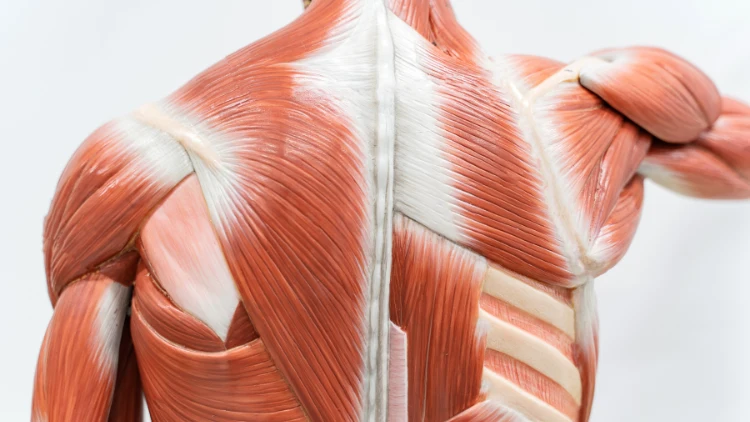
Source: tonaquatic via Canva.com6
The upper back muscles serve the critical role of ensuring that the spine remains aligned to ensure efficient transmission of force and prevent any shearing to the spine which can cause injury. Back muscles also help the leg muscles to lift the bar off the floor into the catch position.
Lower Back Muscles (Erector Spinae, Part of the Lats, Multifidus & Spinalis)
The lower back is crucial in this movement as it assists the other muscle groups during the hip thrust and subsequent partial squat.

Source: Eraxion via Canva.com7
The multifidus is an important stabilizer of the lower back spine in this movement and the spinalis is part of the erector spinae that also helps keep the spine stable and provides support.
Quads (Vastus Medialis, Vastus Lateralis, Rectus Femoris & the Vastus Intermedius)
Quads are the muscles that facilitate knee extension and work together with the hamstrings.
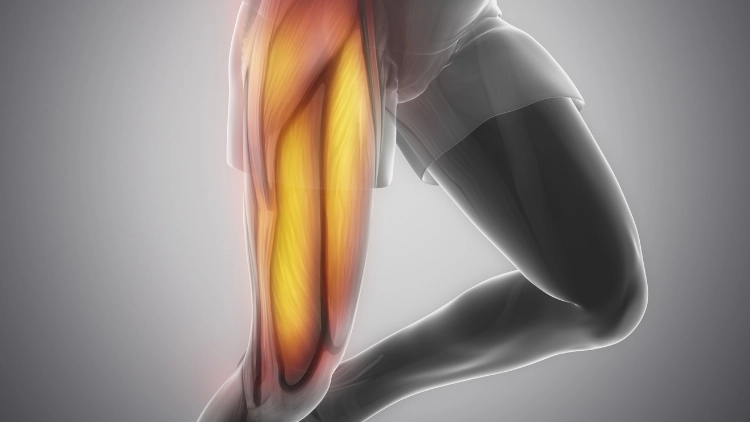
Source: janulla via Canva.com8
During the power clean, they absorb the force of the load during the catch phase and allow the lifter to extend the knees and complete the movement by standing tall with the bar.
Biceps
You may wonder what muscles do power cleans work when done with correct form.
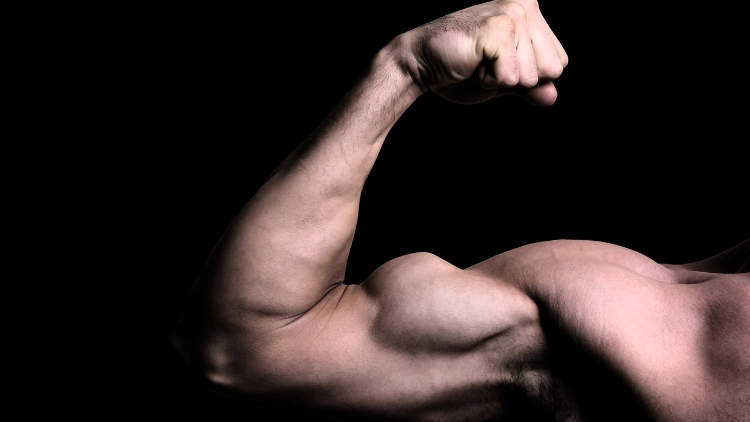
Source: macroworld via Canva.com9
Many would be surprised that the biceps which are muscles of the upper body that sit atop of the upper arm are among those that play a role in the power clean. They perform the function of elbow flexion by providing pulling strength to flex the elbows and allow the arms to position themselves for the catch.
Forearm Flexors
Forearm flexors support the hands to provide strength, dexterity and endurance to perform their pivotal role in the power clean.
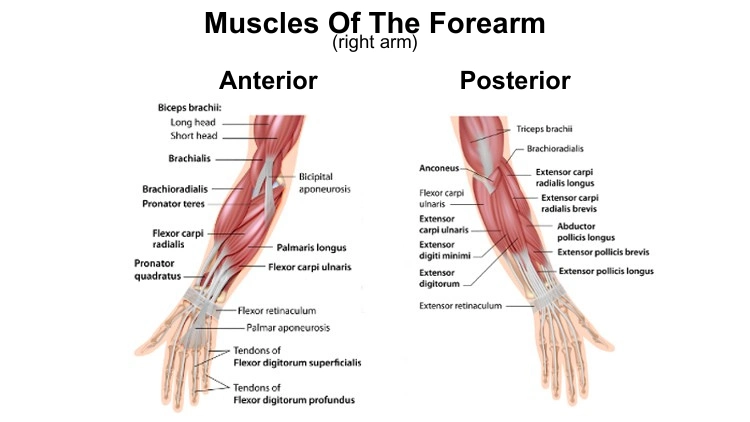
Source: Alila Medical Media on Shutterstock10
Shoulders
The deltoids or shoulder muscles have a very important role in that they provide a shelf to support the barbell during the catch phase.

Source: Science Photo Library via Canva.com11
In addition, they help to work to lift the arms and pull out the elbows during the scoop and second pull.
Core Muscles (Abdominals)
Abdominal muscles (external obliques, internal obliques, pyramidalis, rectus abdominis, transversus abdominis) work together with the lower back muscles to maintain spinal alignment and give the trunk support.
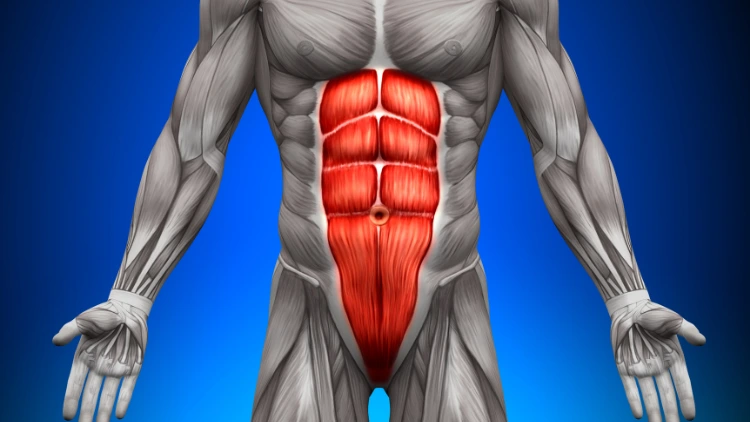
Source: decade3d via Canva.com12
Common Mistakes When Performing the Power Clean
There are several errors that lifters make when doing the power clean that make the movement inefficient, recruit the wrong muscle groups and set up the body for injury. These include lifting with the back and rushing off the floor.
Using the Back for the Lift: Power from the lift must be confined to the lower body and should not come from the back muscles. The back muscles function is to maintain spinal integrity and oftentimes novice lifters can get away with lifting fairly substantial loads with their backs.
Nevertheless, they will hit a plateau where they can no longer lift heavier loads due to recruitment of incorrect muscles.
Bending Arms Too Early: Lifters may often bend the arms too early for the catch phase but this will likely slow the bar down causing it to change direction. There is a high likelihood that the bar will crash down on the shoulders. Instead, lifters should first reach full extension, then proceed to bend their arms.
Using the Arms to Support the Weight: It is quite frequent that lifters use their arms to support the bulk of the weight. The arms’ role should be to only stabilize the weight with the hands, (clavicles) shoulder blades and shoulders forming a shelf to rest the bar on.
This error arises due to lacking wrist mobility and /or having the knees travel too far forward. Lifters should practice the power clean with an unloaded barbell and/or PVC pipe to fine tune their form and improve technique before they progress to weights.
Rushing Off the Floor: Many times, lifters may be in a hurry to get the load off the floor by ripping the barbell off the ground. However, this phase of the lift does not require speed.
The power clean needs to be fast at the hips and rushing it off the ground will likely cause mistakes in other parts of the movement.
Lower Back Hyperextension: The power clean must be performed with an upright and erect torso allowing the spine to maintain its natural curvature. It’s common for lifters to hyperextend (extending the back beyond a neutral position) their lower back during the first pull phase.
This could eventually lead to potential injury.
Allowing the Bar to Veer Away From the Body: Allowing the bar to travel too far from the torso is a common error often seen in lifters during the pull portion. Just like in deadlifts, the barbell should remain as close to the body as it travels up the shins and thighs as this makes for an efficient path for the movement.
When the bar is too far away in both power clean vs deadlift forms, it is harder to stay in position which implies that load progression will be inhibited due to reduced efficiency.
How To Power Clean With Proper Technique (Power Clean Form Trick)
When the power clean is done with proper technique and form, it will lead to a massive progression in the exercise due to performing the exercise with efficiency due to recruitment of the correct power clean muscles worked while also preventing any injury.
One of the biggest mistakes that lifters often do is letting the bar veer off too far from the body during the scoop portion of the movement as they prepare for the catch phase.
This leads to the arms taking the load into the catch position limiting the weight, decreasing efficiency and potentially setting up for injury as the bar could likely crash into the shoulders.
Lifters need to therefore ensure the barbell stays close to the torso to prevent this from happening.
The form trick would be to have the momentum to originate from the hip drive, rather than pulling the bar with the arms into the catch position—therefore as the bar rises up, the lifters need to place themselves under it.
The figure below shows the lifter with the bar in the catch position while using hip drive to have caught the bar.
10 Benefits of Power Cleans
Power cleans provide several benefits that cannot be ignored and should be enough to motivate lifters to learn this movement—these benefits include mastering the triple extension, helps in weight loss and builds muscle.
1. Works the Full Body
The power clean works a significant portion of the body’s musculature. It engages muscles of the posterior chain including the glutes and hamstrings during the initial phase and the anterior (front) muscles of the body including the core muscles, deltoids and quads are heavily recruited in the catch position.
This gives the power clean a more bang for the buck working a good chunk of the body at one go.
2. Enhances Explosive Power Development
Power cleans provides athletes the ability to increase their power and develop their ability to be explosive. It is often used by trainers in sports such as hockey, football and soccer to equip athletes and significantly improve markers of power development.13
Including the power clean into a strength and conditioning routine will boost power development and sports performance particularly for beginners.
3. Allows Lifters To Master the Triple Extension
The triple extension is a maneuver that consists of a simultaneous extension of the ankles, knees and hip joints which improves athletic performances that often utilizes this maneuver.
4. Improves Posture
In society today, many people live sedentary lives which is the biggest contributor to having bad posture. The power clean places a high demand on the posterior chain which results in it becoming stronger and thus restores balance to the body helping improve posture.
5. Builds Muscle & Improves Body Composition
Lifters often wonder which muscles the clean exercises—power cleans can pack on muscles both in the upper and lower body including the glutes, hamstrings, quads, lower and upper back muscles, shoulders and biceps.
As a result, they improve overall body composition due to the demands placed on the body to perform the movement. They are a high intensity exercise and these exercises have shown to be a catalyst for muscle growth and fat loss.14
6. Burns Fat & Aids Weight Loss
The power clean is a calorie burner as the force that is generated and needed to complete the movement by enlisting these large muscle groups will require energy. This increases metabolic rates such that there is a significant after burn effect of calories long after the exercise has been completed and the lifter is at rest.
This is due to the body recovering resources consumed—glycogen resynthesis, removal of lactate after the exercise to return the body to baseline function—this requires energy which continues to burn calories, aid in fat burning and promote weight loss.15 Glycogen is the stored state of glucose which is the body’s main source of energy.
7. Increases Body Awareness & Coordination
Power cleans lets individuals get in tune with their bodies as it encompasses large muscular recruitment which is combined with a complex movement pattern. Enhancing the synergy of these two factors makes lifters more aware of their body’s positions and reduces the risk of injuries.
A 2021 study showed superior intramuscular coordination of lifters who included the power clean when compared to those who did not.16
8. Builds Stronger Bones
The power clean elicits epiphysis loading which leads to micro fractures in the bone shaft as a result of the stresses placed on them. Mechanical epiphysis loading of the bone will result in the bone adapting and getting thicker which makes them less prone to breaking and reduces degenerative diseases such as osteoporosis.17
9. Enhances Anaerobic Endurance
Power cleans will enhance anaerobic endurance of lifters because they are a short, high intensity and explosive movement that taps into the lactic energy and ATP-PC systems. The lactic energy system produces a chemical known as adenosine triphosphate (ATP) which breaks down glycogen in the presence (aerobic) or absence of oxygen (anaerobic).
ATP is the source and storage of energy at the cellular level. Power cleans will facilitate the adaptation of these energy systems which will make the body better at fueling the muscles, thereby enhancing performance.18
10. Increased Growth Hormones
The release of growth hormone is greatly increased during the power clean. Growth hormone is a protein that is produced by the pituitary gland that provides many benefits to the body such as increased muscle mass, enhanced bone density, younger looking skin and faster recovery after exercises.
It should be noted that while power cleans have many benefits, the movement does not carry over into the 3 big lifts—that is deadlifts, bench press and back squats. Power cleans will build explosive strength and they can be found in powerlifting programs such as madcow 5×5 workout and Jonnie Candito training programs.
Variations of the Power Clean
There are a number of variations and alternatives of the power clean and these include hang clean, clean and press and the clean and jerk.
Hang Clean
The hang clean is a similar movement to the power clean but does have some subtle differences to the power clean. A visible difference is the starting position; the hang clean is initiated from a hang position instead of starting from the floor.
The lifter first lifts the bar off the ground placing it in front of the mid upper thighs with arms straight.
The bar is lowered slightly to initiate the movement. The rest of the movement is similar to the power clean except the bar now is caught in a full front squat as opposed to a partial squat in the power clean.
Clean & Press
The clean and press is a progression and step up in intensity to the power clean. Rather than lowering the back after the catch phase, the lifter dips their legs slightly, then drives their hips forward to end the movement by pressing the bar overhead.
This movement requires enhanced coordination, strength and stability. During the catch-phase, the bar is caught in a power and/or partial squat position.
Clean & Jerk
The snatch and clean and jerk are featured and recognized in Olympic weightlifting competition—the clean and jerk has an overhead portion just like the clean and press.
The bar is not pressed overhead but instead the lifters dips their hips and then proceed to explosively power it up in the air. It is swiftly jerked overhead instead of being pressed up.
Catch phase and portion of the clean and jerk are also different. The bar is caught in a full squat position in this movement unlike the clean press where it is caught in a partial squat.
Squat Clean
There is one major difference between the squat clean crossfit movement and the power clean and that is the height at which the lifter catches the bar. The squat clean has the lifter catch the bar below a parallel squat (full squat) where the hip crease is below the top of the thighs.
Power clean of course has the lifter catch the bar when the knees are slightly bent and the hip crease is above the top of the thighs.
Dumbbell & KettleBell Power Cleans
Both these variations discard the use of the barbell and employ either the dumbbell and/or kettlebell. The unilateral aspect introduced by holding a separate weight in each hand helps address muscle imbalances.
However, there is a limit on load progression as opposed to the barbell. The kettlebells also present a unique challenge helping to recruit additional stabilizing muscles.
Power Clean vs Hang Power Clean: Muscles Worked Differences
When comparing the hang clean vs power clean movements there are similarities with the exception for two main differences which are the starting position and the catch-phase.
Starting Position: The main difference between the two is the starting position. Power cleans initiate at the ground while hang power clean will have the starting position at the hips.
As a result, hang cleans demand more hip drive to muster explosive power to drive the load from the hips into the front rack position. Power clean maintains and builds force and momentum throughout its entire range of motion.
Catch-Phase: In the power clean, the bar is caught in a partial squat whereas in the hang clean, the barbell is caught in a full squat.
Hang Power Clean: Muscles Worked
Hang power cleans, similar to power cleans, engage muscles in both the upper and lower body. The hang clean muscles worked include:
- Glutes (gluteus maximus, gluteus minimus, gluteus medius)
- Hamstrings
- Quads (vastus medialis, vastus lateralis, rectus femoris and the vastus intermedius)
- Calves
- Upper back muscles (lats, rhomboids and traps)
- Lower back muscles (erector spinae, part of the lats, multifidus and spinalis)
- Shoulders (deltoids)
- Abdominal muscles (external obliques, internal obliques, pyramidalis, rectus abdominis, transversus abdominis)
- Forearm flexors
- Biceps
- Triceps
DB Power Clean vs Barbell Power Clean: Muscles Worked—Which Is Better?
This depends on the training goals of the lifter and what they are looking to get out of the movement. Nevertheless, both modes of doing the power clean have limitations and merits.
The barbell power clean allows for easier progressive overload meaning lifters can go heavy and do so incrementally allowing them to build explosive raw strength and power.
Dumbbells, however, allow for a unilateral aspect to be introduced in the movement which helps the lifter unmask muscle imbalances that may have been hidden as a result of the use of the barbell.
It offers the same range of motion as its barbell counterpart, but due to the lighter loads, lifters are able to easily master DB power clean since the rack position presents less of a challenge.
Dumbbells are easier to navigate around the body compared to barbells. Dumbbells power clean when performed fairly heavily, challenge grip and upper body strength compared to the same weight on barbells.
Lifters can incorporate both versions of the power clean to get the best of both worlds. Nevertheless, it should be noted that the barbell power cleans are more popular and give more bang for the buck allowing lifters to realize more benefits.
Power Clean Progress Plan
The power clean is clearly an ideal movement that can clearly give athletes and powerlifters explosive power and strength; however, lifters need to improve on the performance of the movement to truly reap its benefits and avoid hitting plateaus when they are no longer making real strength gains.
They should first and foremost master the movement and increase load among other things when power clinging.
Master the Movement: Lifters should ensure that they have perfected the technique in the power clean, making sure that they are doing each phase correctly (the first pull, the scoop, the second pull, the catch and the return). Any phase that is lacking in proper form usually compromises the entire movement.
Increase the Load: Gradually increase the load to increase the intensity and challenge the body’s musculature and focus on 70%-80% of the one rep max that is able to be completed. This will allow the body to adapt and get stronger at each progressive load.
Increase Volume: Training volume is an important component to strength training and is a variable that should also be increased to allow lifters to increase in strength and muscle.19 Target to increase the number of times the movement is completed in a week.
If the training goal is to ultimately be an Olympic powerlifter, then the lifter can now progress to the crown of Olympic weightlift movements which is the clean and jerk. The squat clean could also be another movement to progress to.
The power clean yields plenty of benefits and the power clean muscles worked can lead to developing superior explosive upper and body power but it doesn’t translate into the big 3 compound movements which are the squat, deadlift and bench press—the form trick of ensuring to use hip drive rather the arms to pull the weight into the catch position will be used to improve the power clean and make lifters more efficient at completing it.
Frequently Asked Questions
How Many Times Should You Power Clean in a Week?
It depends on the level of experience. To build strength and endurance, lifters should aim to power clean 2-3 times a week.
Beginners who are learning to master the power clean usually perform the movement 4-5 times a week.
Can You Build Muscle Mass With Power Cleans?
Yes, power cleans are a full body compound movement that build muscle in the upper and lower body targeting the posterior chain and upper body muscles including:
- Hamstrings
- Glutes
- Lower back muscles
- Upper back
- Quads
- Calves
- Deltoids
- Core
- Triceps
Are the Hang Clean Muscles Worked the Same As the Muscles Worked in the Power Clean?
Both movements target the same muscle groups, but the power clean emphasizes the legs more than the hang clean during the pull phase. Conversely, the hang clean activates the leg muscles more than the power clean due to the full squat.
Power Cleans vs Deadlifts: Which Is Better for Muscle Growth?
Power clean is ideal at building muscle for adapted athleticism and powerful acceleration—they will help lifters build explosive strength. Deadlifts can build raw strength bigger muscles compared to the power cleans as lifters are able to lift much heavier. Power cleans should also not be viewed as a deadlift accessory exercise, even if they engage similar muscles.
What Are the Muscles Worked by the Clean and Jerk?
Clean and jerk works both upper and lower body muscles including the:
- Hamstrings
- Quads
- Glutes
- Biceps
- Triceps
- Lower back
- Adductors
- Shoulders (front and lateral deltoids)
- Trapezius
- Forearm flexors
- Core muscles
What Are the Muscles Worked by the Squat Clean? What Are the Muscles Targeted in Full Squat Cleans?
Like the other variations of the power clean, the squat clean engages both upper and lower body muscles including:
- Hamstrings
- Core
- Glutes
- Triceps
- Quads
- Biceps
- Calves
- Trapezius
- Deltoids
- Lower back muscles
Power Clean: What It Is?
A power clean is a full body vigorous movement that has the bar travel fast and explosively from the ground to a racked position on a shelf created by the arms, shoulder blades and shoulders. It is an Olympic weightlifting movement used by CrossFitters, athletes, Olympic weightlifters and regular gym goers to develop explosive strength and power.
References
1Jacob Lund. “Shoulder Press Fitness Exercise.” Canva. Accessed 25 April 2023. <https://www.canva.com/photos/MABjwF5Rz2s-shoulder-press-fitness-exercise/>
2decade3d. Canva. Accessed 22 April 2023. <https://www.canva.com/photos/MADerAJvWMU-gluteus-maximus-anatomy-muscles/>
3decade3d. Canva. Accessed 22 April 2023. <https://www.canva.com/photos/MADerMxdfBI-hamstrings-anatomy-muscles/>
4Science Photo Library. “A posterior view of the muscles of the thigh.” Canva. Accessed 25 April 2023. <https://www.canva.com/photos/MADmTKLpubE-a-posterior-view-of-the-muscles-of-the-thigh-/>
5decade3d. Canva. Accessed 22 April 2023. <https://www.canva.com/photos/MAC_U2yFahk-calves-anatomy-muscles/>
6tonaquatic. Canva. Accessed 22 April 2023. <https://www.canva.com/photos/MADKZXi5XqU-muscles-of-the-back-model-for-physiology-education-/>
7Eraxion. Canva. Accessed 22 April 2023. <https://www.canva.com/photos/MADAUv7xTN8-muscle-pain-in-the-back/>
8janulla. Canva. Accessed 22 April 2023. <https://www.canva.com/photos/MADAhbO1cbM-thigh-man-muscle-anatomy/>
9macroworld. Canva. Accessed 22 April 22, 2023. <https://www.canva.com/photos/MAEJeh8OM1Q-bicep/>
10“Muscles Forearm Anterior Posterior View Stock Illustration 147943889.” Shutterstock. Accessed 22 April 2023. <https://www.shutterstock.com/image-illustration/muscles-forearm-anterior-posterior-view-147943889>
11Science Photo Library. Canva. Accessed 22 April 2023. <https://www.canva.com/photos/MADmTMcCTkw--shoulder-muscles/>
12decade3d. Canva. Accessed 22 April 2023. <https://www.canva.com/photos/MADerFwn3js-abs-anatomy-muscles/>
13Lachlan P James, P. C. (2019, November). Influence of Power Clean Ability and Training Age on Adaptations to Weightlifting-Style Training. Retrieved 2023, from <https://pubmed.ncbi.nlm.nih.gov/29547489/>
14Michael A Wewege, I. D. (2022, February). The Effect of Resistance Training in Healthy Adults on Body Fat Percentage, Fat Mass and Visceral Fat: A Systematic Review and Meta-Analysis. Retrieved 2023, from <https://pubmed.ncbi.nlm.nih.gov/34536199/>
15Boutcher, S. H. (2010, November 24). High-Intensity Intermittent Exercise and Fat Loss. Retrieved 2023, from <https://www.ncbi.nlm.nih.gov/pmc/articles/PMC2991639/>
16Paulo D. G. Santos, J. R.-C. (2021, March 9). Intermuscular Coordination in the Power Clean Exercise: Comparison between Olympic Weightlifters and Untrained Individuals—A Preliminary Study. Retrieved 2023, from <https://www.ncbi.nlm.nih.gov/pmc/articles/PMC7963197/>
17Timothy A. Mirtz, J. P. (2011, February 12). The Effects of Physical Activity on the Epiphyseal Growth Plates: A Review of the Literature on Normal Physiology and Clinical Implications. Retrieved 2023, from <https://www.ncbi.nlm.nih.gov/pmc/articles/PMC3194019/>
18Thomas L Stöggl, G. B. (2017, August 2). High Intensity Interval Training Leads to Greater Improvements in Acute Heart Rate Recovery and Anaerobic Power as High Volume Low Intensity Training. Retrieved 2023, from <https://pubmed.ncbi.nlm.nih.gov/28824457/>
19Davi Alves de Santana, A. C. (2021, September 30). Strength Training Volume to Increase Muscle Mass Responsiveness in Older Individuals: Weekly Sets Based Approach. Retrieved 2023, from <https://www.ncbi.nlm.nih.gov/pmc/articles/PMC8514686/>